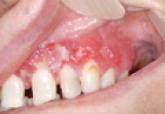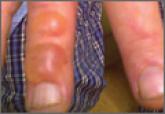Case Letter

Hemorrhagic Bullous Lesions Due to Bacillus cereus in a Cirrhotic Patient
Traditionally considered in the context of foodborne illness, Bacillus cereus is recognized increasingly as a cause of systemic and local...
Anna H. Chacon, MD
From the University of Maryland Medical Center, Baltimore.
The author reports no conflict of interest.
Correspondence: Anna H. Chacon, MD, 419 W Redwood St, Ste 240, Baltimore, MD 21201 (annachaconmd@gmail.com).

Necrotizing Fasciitis
Dermatology residents may frequently encounter necrotizing fasciitis, either in clinic or on the wards (Figure 3). Recognition of the skin signs in this condition is essential to patient survival. As an intern, I once had an attending teach me that patients with necrotizing fasciitis only have a couple of hours to live. The rapid unfolding of this flesh-eating disease and its high morbidity and mortality has led to recent attention in the press and media.
 Figure 3. Necrotizing fasciitis of the left forearm following debridement of the skin, subcutaneous tissue, and fascia, revealing the remaining muscle, tendon, and bone.
Figure 3. Necrotizing fasciitis of the left forearm following debridement of the skin, subcutaneous tissue, and fascia, revealing the remaining muscle, tendon, and bone.
Figure 3. Necrotizing fasciitis of the left forearm following debridement of the skin, subcutaneous tissue, and fascia, revealing the remaining muscle, tendon, and bone.
Although necrotizing fasciitis may be caused by several different bacterial organisms (eg, gram positive, gram negative, polymicrobial), it usually is rapidly progressive, destroying muscle and subcutaneous tissues in a matter of hours.3 Bacteria usually enter through a traumatic or present wound and quickly move along fascial planes, destroying blood vessels and whatever subcutaneous tissues happen to be in the way. Within the first few hours, the involved area that was initially erythematous becomes indurated, woody, extremely painful, and dusky, indicating a lack of circulation to the area. Extensive debridement is required until reaching noninfected tissue that is no longer purulent, necrotic, or woody to the touch. If necrotizing fasciitis is not diagnosed and treated early, patients may lose one or several limbs and death may occur.
Key findings of necrotizing fasciitis include systemic toxicity, localized painful induration, well-defined dusky blue discoloration, and a lack of bleeding or purulent discharge on incision and squeezing of the affected tissue. Crepitation or a crackling sensation can occasionally be felt when palpating the area secondary to gas formation in the tissue, though it is not always present. Patients with necrotizing fasciitis often initially present to dermatology clinics because the first manifestation happens to be in the skin. The role of dermatologists in treating this critical condition may prompt recognition and collaboration with other specialists to reach a viable outcome for the patient.3

Traditionally considered in the context of foodborne illness, Bacillus cereus is recognized increasingly as a cause of systemic and local...

Orificial tuberculosis (OT) constitutes 2% of cutaneous tuberculosis cases and 0.01% to 1% of all clinical presentations of tuberculosis. It is...

Frostbite is a form of localized tissue injury due to extreme cold that most commonly affects the hands and feet, with the greatest incidence...
